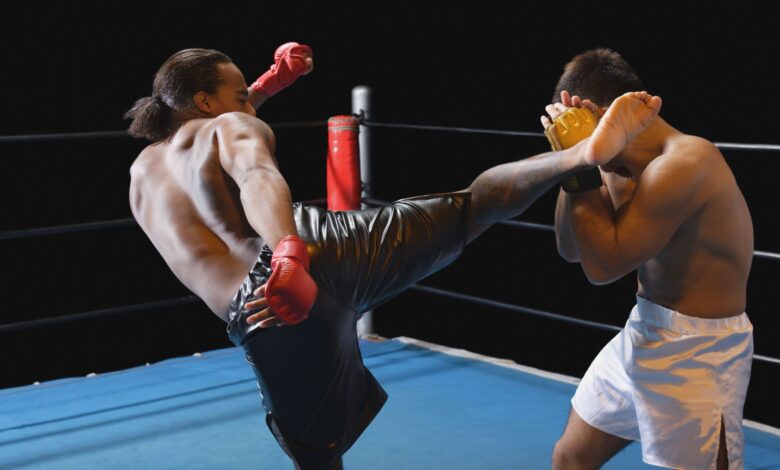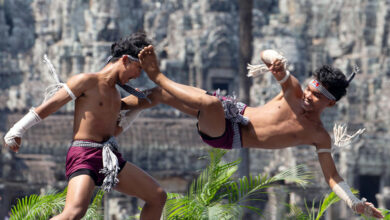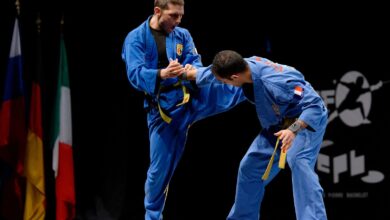
Martial Arts: Kickboxing is a modern combat sport and martial art that blends elements of traditional martial arts with Western boxing techniques. It emphasizes powerful punches, kicks, knee strikes, and defensive maneuvers.
Kickboxing is practiced worldwide for self-defense, competition, and fitness. It has influenced and been influenced by various striking disciplines, making it a cornerstone of modern stand-up fighting.
History and Origins
Kickboxing has diverse roots, originating from different martial traditions:
- Muay Thai (Thailand) – Known as the “Art of Eight Limbs,” Muay Thai heavily influenced modern kickboxing with its striking techniques using fists, elbows, knees, and shins.
- Karate (Japan) – Japanese kickboxing evolved from full-contact karate, incorporating high kicks and fluid movement.
- Western Boxing – The defensive footwork, head movement, and punching combinations of boxing were integrated into kickboxing.
- Savate (France) – A French martial art that combines agile footwork with precise kicks, influencing European kickboxing styles.
The modern form of kickboxing emerged in the 1960s and 1970s, with notable contributions from Japan and the United States. Pioneers like Tatsuo Yamada and Osamu Noguchi formalized Japanese kickboxing, while American kickboxing grew under the influence of fighters like Joe Lewis and Bill Wallace.
Styles and Variants of Kickboxing
There are multiple styles of kickboxing practiced globally, each with distinct rules and techniques:
- Japanese Kickboxing – Originated in the 1960s, blending Muay Thai and Karate techniques with traditional boxing elements.
- American Kickboxing – Developed in the 1970s, emphasizing high kicks and punches while restricting elbow and knee strikes.
- Muay Thai (Thai Kickboxing) – A full-contact sport allowing punches, kicks, elbows, knees, and clinch fighting.
- Dutch Kickboxing – A hybrid style combining Muay Thai, Western boxing, and Kyokushin Karate, known for its aggressive combinations and strong conditioning.
- K-1 Kickboxing – A highly popular tournament format featuring international fighters with modified rules that encourage high-paced striking.
- Chinese Kickboxing (Sanda) – A Chinese martial art that integrates kickboxing techniques with wrestling throws and sweeps.
Techniques and Training
Kickboxing training focuses on a combination of striking, footwork, and conditioning. Key components include:
Striking Techniques
- Punches: Jab, Cross, Hook, Uppercut.
- Kicks: Roundhouse Kick, Front Kick, Side Kick, Axe Kick, Spinning Back Kick.
- Knee Strikes: Straight Knee, Flying Knee, Round Knee.
- Elbow Strikes (in Muay Thai and some variations): Horizontal Elbow, Uppercut Elbow, Spinning Elbow.
Defensive Maneuvers
- Blocking: Using arms and legs to absorb strikes.
- Parrying: Redirecting incoming punches.
- Head Movement: Slipping and ducking to avoid strikes.
- Footwork: Maintaining mobility to control distance and angles.
Conditioning and Strength Training
- Endurance training through running, skipping rope, and shadowboxing.
- Strength training using bodyweight exercises, weights, and resistance drills.
- Pad work and heavy bag training to develop power and precision.
Competitive Kickboxing and Rules
Kickboxing competitions vary based on governing organizations and styles. Major organizations include:
- K-1: One of the most prestigious kickboxing circuits, allowing punches, kicks, and knee strikes.
- Glory Kickboxing: A leading promotion featuring elite fighters worldwide.
- WAKO (World Association of Kickboxing Organizations): Governs amateur and professional kickboxing competitions.
- ISKA (International Sport Karate Association): Oversees various kickboxing rule sets globally.
Common competition rules include:
- Full-Contact: Fighters aim for knockouts, with points scored for clean strikes.
- Semi-Contact: Points awarded for controlled techniques with minimal force.
- Low Kick Rules: Allows leg kicks in addition to standard kickboxing strikes.
- K-1 Rules: Permits limited clinching and knee strikes.
Kickboxing for Self-Defense and Fitness
Beyond competition, kickboxing is a practical tool for self-defense and an excellent workout. Benefits include:
- Improved Cardiovascular Health: High-intensity training boosts endurance and heart health.
- Weight Loss and Muscle Toning: Full-body workouts enhance muscle definition and fat burning.
- Self-Defense Skills: Effective striking techniques for real-world situations.
- Mental Resilience: Enhances confidence, discipline, and stress relief.
Influence on Mixed Martial Arts (MMA)
Kickboxing plays a crucial role in MMA, providing fighters with superior striking abilities. Many renowned MMA champions have backgrounds in kickboxing, using its techniques to dominate stand-up exchanges.
Kickboxing is a versatile and powerful martial art that continues to grow in popularity worldwide. Whether for sport, fitness, or self-defense, it offers practical striking skills, physical conditioning, and mental discipline. With a rich history and ongoing evolution, kickboxing remains a staple in combat sports and martial arts training.



